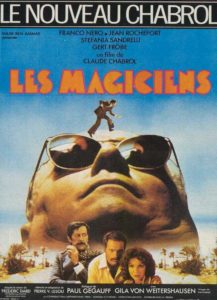 A lesser film from the late “French Hitchcock” Claude Chabrol. Adapted from a novel by the well-regarded French noir specialist Frederic Dard, this French-Italian-German co-production, pivoting on clairvoyance and murder, is definitely peculiar, and for that reason alone deserves a look. But be forewarned: Chabrol himself allegedly regarded DEATH RITE as “very bad.”
A lesser film from the late “French Hitchcock” Claude Chabrol. Adapted from a novel by the well-regarded French noir specialist Frederic Dard, this French-Italian-German co-production, pivoting on clairvoyance and murder, is definitely peculiar, and for that reason alone deserves a look. But be forewarned: Chabrol himself allegedly regarded DEATH RITE as “very bad.”
Released in 1976, the film marked Chabrol’s final collaboration with his longtime screenwriting partner Paul Gegauff, and remains one of his least seen films. Its sole availability in America was via an English dubbed release that’s now quite obscure.
The ultra-twisty narrative begins with an eccentric man named Edward Vanguard (Jean Rochefort) on a sightseeing trip in Tunisia. There he meets up with Professor Vestar (Gert Frobe), a stage magician and alleged clairvoyant. Vestar claims to have foreseen an unidentified somebody (he can’t say if it’s a man or a woman) getting strangled to death on a deserted beach, through which he and Edward happen to be driving. Upon that beach a woman, Sylvia (Stefania Sandrelli) is thrown from a horse, and the two men attend to her.
Enter the Italian tourist Sadry (Franco Nero), who’s vacationing in Tunisia together with his wife, who happens to be the horse-thrown Sylvia. Sadry runs into Martine (Gila von Weitershausen), an old flame, which only makes him realize how stale his marriage to Sylvia has grown.
Back to Edward, who, intrigued about Vestar’s prophecy, decides to pose as a psychic himself, in which guise he informs Sylvia that it was he who experienced Vestar’s prophecy. Edward also describes the prophecy to Sadry, and in the process invents all sorts of extraneous details, including a statuette he predicts will be given to Sylvia by Sadry, and also the identity of the killer: Sadry himself!
Then Sylvia spots Sadry with Martine and grows jealous. This drives her into the arms of Edward. Sadry, meanwhile, grows increasingly paranoid and unstable, and snaps entirely when Sylvia accidentally breaks the statuette that figured so heavily in Edward’s faux-psychic vision. It seems the prophetic strangling may indeed be about to come true, but not in a way any of the characters, including the psychically-endowed Vestar, could have foreseen.
DEATH RITE is not what I’d call a “good” movie, but it does have its pleasures. Foremost among them is the sight of Franco Nero essaying another of the temperamental psycho roles in which he specialized during the sixties and seventies (see also A QUIET PLACE IN THE COUNTRY and HITCH-HIKE), and the slow-building narrative that grows tighter and more absorbing as it advances. Also, certain sequences, such as Edward’s stalking of Martine through an outdoor resort, recall, in the skillfully wrought camerawork, Chabrol’s work in earlier, better films like LE BOUCHER and THIS MAN MUST DIE. A more concrete comparison, given the exotic locale, evocative cinematography and psychic-themed narrative, would be DON’T LOOK NOW.
But the film’s stylish visuals don’t excuse the fatally half-baked narrative, which Chabrol tries to paper over with a lot of miscellaneous Tunisian scenery, a gratuitous sex scene, a protracted magic show sequence, etc. This doesn’t make for a terrible film—the suspenseful final scenes in particular are quite strong—but it does make for one that never quite attains its full potential.
Vital Statistics
DEATH RITE (LES MAGICIENS)
Carthago Films
Director: Claude Chabrol
Producer: Tarak Ben Ammar, Jean Boujnah, Tablouti Temini
Screenplay: Adriano Bolzoni, Pierre V. Lesou, Claude Chabrol, Paul Gegauff
(Based on a novel by Frederic Dard)
Cinematography: Jean Rabier
Editing: Monique Fardoulis
Cast: Franco Nero, Stefania Sandrelli, Jean Rochefort, Gert Frobe, Gila von Weitershausen, Moheddine Mrad, Jalila Baccar, Madame Ben Chadly, Habvib Chaari, Cecile Labussiere
